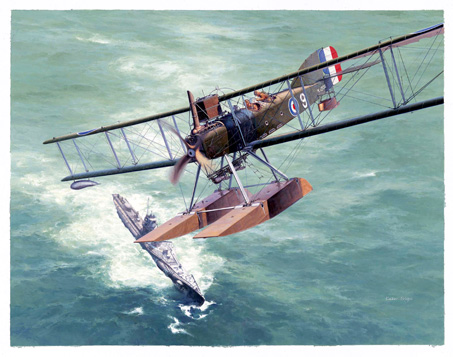Another detail tour-de-force by Koike with a painting which shows off all the rigging, radiator ribs, bomb racks and other little bits of the Short Type 184, the first aircraft in history to successfully torpedo a ship. While Koike seldom shows “action” in his recent work, the hint of things to come permeate this shot of a 184 on anti-submarine duty.
A Short 184 floatplane of the type built by Peller’s Westland Aircraft Works during 1915-16.
The first Westland-built Short 166 floatplane, 9751, in the Yeovil factory, with the Salmson radial engine of another aircraft visible at the left of the photograph.
In 1915 and Westland Aircraft Works at Yeovil, among Robert Bruce’s early tasks was the employment of a team of draughtsmen and craftsmen. It has been recorded that he enlisted his wife’s help in preparing drawings for assembly jigs, thus certainly making her the British aircraft industry’s first female jig and tool draughtsman-if that is not a contradiction in terms.
The first to be recruited from Petters was 24-year-old engine designer Arthur Davenport who was appointed chief draughtsman. A number of craftsmen transferred from the Nautilus Works and they were joined by carpenters, joiner and mechanics from other local companies. In addition to human resources Bruce was aware of the need to provide them with modern ‘tools’; thus he was responsible for the installation of an open-circuit wind tunnel-or ‘wind channel’ as it was named at that time. This tunnel was modified and more powerful motors were gradually installed until, in 1938, it became a closed-circuit tunnel with an open working section. In 1942 it finally became a fully closed-circuit tunnel.
In response to an Admiralty telegram of 24 June, Davenport was sent to Sheerness on the Isle of Sheppey to where the third production Short 184. serialled 843, had been delivered for examination and measurement by representatives of the five companies sub-contracted to built this type of f1oatplane. The other four were Mann, Egerton & Co. Norwich; Phoenix Dynamo Co at Bradford; Frederick Sage & Co, Peterborough; and S E Saunders Ltd, East Cowes. At Sheerness. Davenport and the other representatives were shown over the aircraft and then they had to produce drawings to enable them to be built at their respective factories. During this visit Davenport became friendly with Victor Gaunt from Phoenix Dynamo; this friendship was to be of great value to Westland in the years ahead when Gaunt became superintendent of the company’s experimental department.
By early August, production of Westland’s first Short 184. serialled 8356, had started and was completed by the end of December. On 1 January, 1916, having been dismantled, it left the factory on three horse-drawn carts and was taken to Yeovil Junction on the Great Western Railway. Later in the year, sidings were built in the factory so that the crated aircraft could travel all the way by rail. From there it went by rail to Hamble where the Admiralty had provided Richard Fairey with a site on the Spit at the confluence of the Hamble River and Southampton Water, at which Short 827 float planes, also built under subcontract, were test flown by Sydney Pickles, a freelance test pilot. Here, Westland’s first aeroplane was assembled, test flown and, it is believed, was delivered to the RNAS coastal air station on Calshot Spit across Southampton Water. The story of the part which the fourth floatplane built by Westland, serialled 359, played in the Battle of Jutland during May-June 1916.
When production of these twelve floatplanes was nearing completion, Westland received a second sub-contract order. This was for a batch of twenty Short Type 166 floatplanes powered by 200 hp Salmson liquid-cooled radial engines which embodied the patented Swiss Canton-Unne design feature in which all the connecting rods drove a cage revolving on the crank pin on epicyclic gears. These floatplanes were of an earlier design than the Type 184 and only six had been produced by Shorts at Eastchurch on the Isle of Sheppey. Whether it was the small size of this batch or the Type 166’s similarity to the even earlier Type 136, enabling them to be built ‘by hand and eye’, it is impossible to establish, but Shorts was unable to supply Westland with a complete set of production drawing. There was an additional problem in that the twenty Westland aircraft were to be built without torpedo carrying equipment, necessitating some redesign by Bruce and Davenport and the production of the missing drawings. In spite of these difficulties, which underlined the need to expand Westland’s design office, the first Short 166. 9751, was delivered to Hamble for flight testing on 1 July, 1916.
